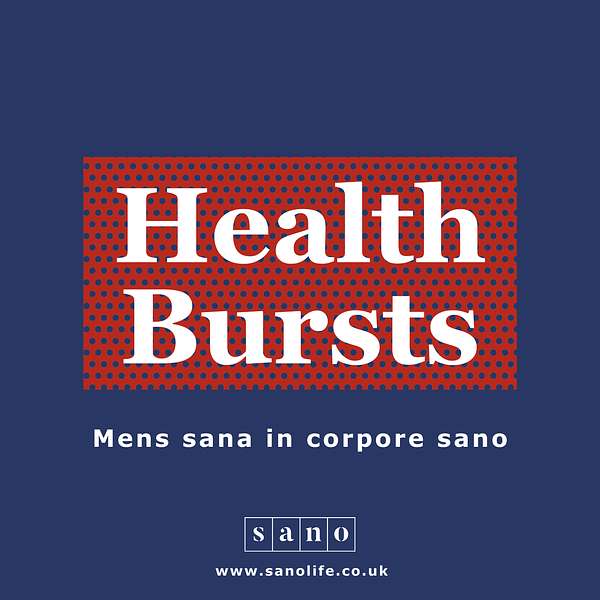
Sano Health Bursts
Sano Health Bursts
Go beyond '5 a day' with a colourful diet
Why is it important to 'Eat the Rainbow', and what exactly does that mean? In this episode we examine the importance of including a wide variety of colourful plants within the diet and not limiting this to vegetables and fruits or the '5 portions a day' guidance.
Welcome to Sano Health Bursts. I’m Heather Richards Nutritional Therapist, Director of Nutrition at Sano and nutrition lead for the College of Medicine. Sano Health Bursts are short, informative, practical sessions discussing food, nutrition and lifestyle, helping you live a healthier life.
Today we’re discussing why we need colour in our diet. We frequently hear the phrase ‘Eat the Rainbow’ but what does that actually mean and why is it important?
Plants contain phytochemicals. ‘Phyto’ means relating to plants, so phytochemicals are chemicals or compounds relating to plants. They give plants their colour, taste and smell and can provide them with protection against things like the environment, microbes and insects. Phytonutrients can have a beneficial impact on human health when we eat the plants.
In nutrition when we talk about ‘essential nutrients’ we mean nutrients that have been deemed through scientific research to be ‘essential’ for the body to function and that we can’t synthesise ourselves. In other words we must ingest them and without them deficiency diseases occur. For example a severe deficiency in vitamin C has been shown to result in scurvy. Unlike vitamins and minerals phytonutrients aren’t classified as essential. However, this doesn't mean they don’t have significant benefits for our health.
Also it’s important to remember that plants contain an array of vitamins, minerals and phytonutrients. Throughout our daily and weekly diet we require a broad spectrum of nutrients and by consuming a rainbow of colours we can achieve this target!
So let's look at some examples. Blueberries contain vitamin C, K and manganese and various phytochemicals including anthocyanins that are powerful antioxidants. Anthocyanins are also beneficial in supporting cardiovascular health aiding in the reduction in blood pressure and having a beneficial impact on total cholesterol.
Orange and yellow fruit and vegetables contain beta-carotene that can be converted to vitamin A and is also a fat soluble antioxidant.
Turmeric contains the curcumoid, curcumin that has many beneficial roles in the body. It acts as an anti-inflammatory, an antioxidant and increases a compound brain derived neurotrophic factor, or BDNF for short, involved in the growth of neurons, important for our mental health.
Cacao, as well as containing good amounts of protein and fibre and micronutrients like potassium, magnesium, iron, zinc and copper, contains an array of phytochemicals. These have varying health benefits supporting reduced inflammation, cardiovascular health, brain function and mental health as well as acting as an antioxidant.
Broccoli is rich in a wide large variety of vitamins and minerals including vitamin C and phytochemicals, too many to discuss here. To mention a few, lutein and zeaxanthin are important to eye health and sulforaphane supports detoxification and brain function.
Buckwheat contains significant amounts of fibre and protein, manganese, copper, magnesium, iron and phosphorus. It also contains phytochemicals including rutin and quercetin that act as antioxidants.
These are just a few examples. As you can see there is an enormous benefit of eating the rainbow; eating a wide variety of different coloured plants. Even though you might think adding a teaspoon of turmeric to your cooking won’t have an impactful health benefit, when a variety of phytochemicals are included regularly in diet they will have a cumulative and beneficial effect. Don’t limit your rainbow to 5 vegetables and fruits a day. Think much more broadly and include plenty of different coloured plants from vegetables, fruits, herbs, spices, nuts, seeds and whole grains.
I challenge you to see how many different plants you can include within your diet in the week. This might sound difficult but once you start to think differently you’ll find yourself naturally adding more colour; cinnamon on porridge, turmeric latte, a handful of blueberries with breakfast, red pepper and carrot sticks with hummus instead of the sugary processed snack, extra broccoli florets on a salad. The list is endless.
It doesn't matter where you are in your health journey. Whatever number of different plants you include this week, next week aim a little higher and so on reaping the benefits to improve your health.
I hope you enjoyed this episode of Sano Health Bursts. If you want to learn more then subscribe to this podcast, to our newsletter, read our blogs, join our webinars or study with us. Visit our website www.sanolife.co.uk or email us at learn@sanolife.co.uk to find out more and enrol on our courses. Start improving your health today and put the tips I have given you into practice. Mens sana in corpore sano. A healthy mind in a healthy body.
www.sanolife.co.uk
Copyright Sano 2021